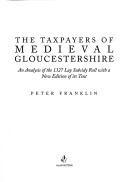History/prehistory & Medieval History
1 total work
The escalating costs of medieval warfare were met by raising large sums through taxation, and, for a time, the government kept detailed records of the names of every single taxpayer in each county. These lists grouped taxpayers according to where they lived and noted how much each person had to pay. The Gloucestershire 'Lay Subsidy Roll' of 1327, drawn up in the year King Edward II was killed at Berkeley Castle, is one such list and forms the subject of this book. In his introduction Dr Franklin not only provides insights into Gloucestershire society in the Middle Ages, he also offers a general introduction to the complexities of medieval taxation which will be of interest to all local historians, including those who are primarily concerned with later periods. As a case study, the author also traces the taxpayers from one local community (Thornbury Manor) in manorial records. The bulk of the work consists of the full list of 9,000 names of Gloucestershire taxpayers from the year 1327, together with indices of their names and of the parishes where they lived. The book's novel feature is the tracing of the taxpayers from a particular area in independent local records. This has never been done in detail for any part of medieval England. The combination of records makes it possible to show who paid tax and who did not do so, how 'fair' the assessments of individual taxpayers were, and just how useful tax lists of this kind are to historians. This tax list has been transcribed only once previously, by Sir Thomas Phillipps, who published his version privately in 1856. This completely new edition of the text has been made from the original manuscript held in the Public Record Office. It makesavailable in an accessible form an important source for both local and medieval historians.
